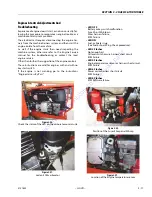
SECTION 3 - CHASSIS & TURNTABLE
3-2
– JLG Lift –
3121623
Checking The Rubber Tracks
Figure 3-3. Rubber Track Structure
The structure of the rubber track is illustrated in Figure 3-3.
The steel ropes and the metal core are imbedded into the
rubber. The carved profiles are used to give traction when
moving over loose land. They are situated in the lower
part resting on the ground, while the wheel guides situ-
ated inside the track, prevent the track from escaping
from the guide rollers.
CAUSES OF DAMAGE
1.
Breakage of the steel ropes
Excessive tension causes the steel ropes to break
in the following conditions:
a.
when stones or foreign bodies accumulate
between the track and the under-carriage
frame;
b.
when the track escapes from its guide;
c.
in the case of strong friction such as rapid
direction changes.
2.
Wear and breakage of the metal cores
As for breakage of the steel ropes, stated above,
excessive tension may cause the metal cores to
bend or break, as may the following causes:
a.
incorrect contact between toothed wheel
and track;
b.
breakage of internal rollers;
c.
functioning on sandy land.
Figure 3-4.
3.
Separation of the metal cores
a.
The metal core acts as a type of adhesive of
the rubber between the core itself and the
steel ropes. Separation may be caused by
excessive tension as breakage of the ropes
for the following reasons:
b.
The metal cores have been wound by the
worn toothed wheel as indicated in the fig-
u r e . W h e n t h i s w e a r a n d a b r a s i o n i s
detec ted, the toothed wheel must be
replaced as soon as possible.
c.
If it breaks, as stated in item 2, "Wear and
breakage of the metal cores", the track must
be replaced because this damage leads to a
complete loss of functions.
4.
Abrasion and fatigue cracks
a.
The cracks at the base of the carved profile
occur due to bending fatigue of the rubber
caused by the toothed wheel and the track-
tensioning wheel.
b.
The cracks and bends on the edge of the
rubber are due to manoeuvres with the
track in presence of cement kerbs and
edges.
Figure 3-5.
c.
The cracks and abrasions in the rubber on
the tracks of the roller guide originate from
fatigue from the compression of the rubber
by the weight of the wheel, together with
functioning on sandy land, or repeated and
abrupt changes of direction.
d.
Abrasion of the carved profiles may occur
especially if slewing on concrete surfaces or
on gravel or hard surfaces are carried out.
PATTERN
WHEEL SIDE
SPROCKET
HOLE
METAL CORE
STEEL WIRE
g
WORN PARTS
CRACK
Go to
Discount-Equipment.com
to
order your
parts





































